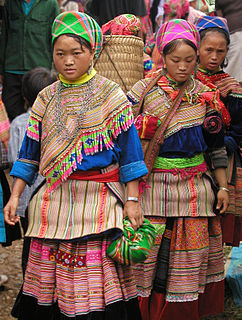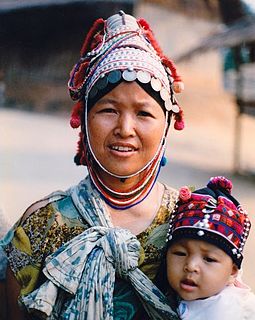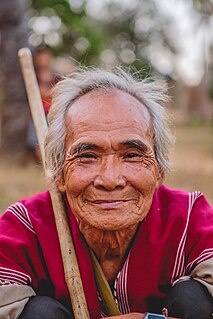
Laos, officially the Lao People's Democratic Republic, is a socialist state and the only landlocked country in Southeast Asia. At the heart of the Indochinese Peninsula, Laos is bordered by Myanmar and China to the northwest, Vietnam to the east, Cambodia to the southeast and Thailand to the west and southwest. Its capital and largest city is Vientiane.

The Hmong people are an ethnic group which mainly lives in southern China, Vietnam, Laos, Thailand, and Myanmar. They have been members of the Unrepresented Nations and Peoples Organization (UNPO) since 2007. In China they are classified as a subgroup of the Miao people.

Kayah State is a state of Myanmar. Situated in eastern Myanmar, it is bounded on the north by Shan State, on the east by Thailand's Mae Hong Son Province, and on the south and west by Kayin State. It lies approximately between 18° 30′ and 19° 55′ north latitude and between 96° 50′ and 97° 50′ east longitude. The area is 11,670 km2 (4,510 sq mi). Its capital is Loikaw. The estimated population in 1998 was approximately 207,357, according to UNICEF. It is inhabited primarily by the Karenni ethnic group, also known as Red Karen or Kayah, a Sino-Tibetan people.

The Karen are an ethnolinguistic group of Sino-Tibetan language–speaking peoples. The group as a whole is heterogeneous and disparate as many Karen ethnic groups do not associate or identify with each other culturally or linguistically. These Karen groups reside primarily in Kayin State, southern and southeastern Myanmar. The Karen, approximately five million people, account for approximately seven percent of the Burmese population. Many Karen have migrated to Thailand, having settled mostly on the Thailand–Myanmar border. A few Karen have settled in the Andaman and Nicobar Islands, India, and other Southeast Asian and East Asian countries.
Johnny Htoo and Luther Htoo are twin brothers who jointly led the God's Army guerrilla group, a splinter group of the Karen National Union, in Myanmar (Burma) during the late 1990s.
God's Army was an armed revolutionary Christian resistance group that opposed the then military junta of Myanmar (Burma). The group was an offshoot of the Karen National Union. They were based along the Thailand-Burma border, and conducted a string of audacious guerrilla actions including allegedly being involved in the seizure of the Myanmar embassy in Bangkok in 1999. They have been described as a terrorist organisation.
Hmong Americans are Americans of Hmong ancestry. Most Hmong Americans consist of those that fled to the United States as refugees in the late 1970s due to their cooperation with the United States' Central Intelligence Agency operatives in northern Laos during the Vietnam War, and their descendants. Over half of the Hmong population from Laos left the country, or attempted to leave, in 1975, at the culmination of the war. At the time, the Pathet Lao launched an aggressive campaign to capture or kill Hmong soldiers and families who aided the CIA. Thousands of Hmong were evacuated or escaped on their own to Hmong refugee camps in Thailand. About 90% of those who made it to refugee camps in Thailand were ultimately resettled in the United States. The rest, about 8 to 10%, resettled in countries including Canada, France, the Netherlands, and Australia. According to the 2019 American Community Survey by the US Census Bureau, the population count for Hmong Americans was 327,000.
Burmese Americans are Americans of full or partial Burmese ancestry. The term encompasses people of all ethnic backgrounds with ancestry in present-day Myanmar, regardless of specific ethnicity. They are a subgroup of Asian Americans. The majority of Burmese Americans are of Burmese Chinese descent, particularly Teochew, Hokkien, and Yunnanese, rather than Bamar, the dominant ethnic group in Myanmar; they may alternatively identify as simply Chinese Americans. However, other types of Burmese ethnic groups immigrating to the U.S. have been on the rise in recent years.

The situation of human rights in Laos has often been, and remains, a recognized cause for serious concern. Laos is one a handful of Marxist-Leninist governments and is ruled by a one-party communist government backed by the Lao People's Army in alliance with the Vietnam People's Army and the Socialist Republic of Vietnam in Hanoi.

The United States Census Bureau counted Minnesota's population at 5,303,925 in the 2010 Census.

Christianity in Myanmar has a history dating to the early 18th century. According to the 2016 census, Christianity is the country's second largest religion, practiced by 6.3% of the population, primarily among the Kachin, Chin and Kayin, and Eurasians because of missionary work in their respective areas. About four-fifths of the country's Christians are Protestants, in particular Baptists of the Myanmar Baptist Convention; Roman Catholics make up the remainder.

The Kayan are a sub-group of Red Karen, Tibeto-Burman ethnic minority of Myanmar (Burma). The Kayan consists of the following groups: Kayan Lahwi, Kayan Ka Khaung (Gekho), Kayan Lahta, Kayan Ka Ngan. Kayan Gebar, Kayan Kakhi and, sometimes, Bwe people (Kayaw). They are distinct from, and not to be confused with, the Kayan people of Borneo.

Insurgencies have been ongoing in Myanmar since 1948, the year the country, then known as Burma, gained independence from the United Kingdom. The conflict has largely been ethnic-based, with several ethnic armed groups fighting Myanmar's armed forces, the Tatmadaw, for self-determination. Despite numerous ceasefires and the creation of autonomous self-administered zones in 2008, many groups continue to call for independence, increased autonomy, or the federalisation of the country. The conflict is the world's longest ongoing civil war, having spanned more than seven decades.

The S'gaw,(S'gaw Karen: စှီၤ or ပှၤကညီဖိ) also known as Skaw, S'gaw, S'gau, White Karen, Paganyaw, Pgaz Cgauz and Pakayo, are an ethnic group of Burma and Thailand. They speak the S'gaw Karen language.

Relations between Laos and the United States officially began when the United States opened a legation in Laos in 1950, when Laos was a semi-autonomous state within French Indochina. These relations were maintained after Lao independence in October 1953.

Mae La, Beh klaw ,(S'gaw Karen: မဲၣ်လးဒဲကဝီၤ, ဘဲကျီး) is a refugee camp in Thailand. It was established in 1984 in Tha Song Yang District, Tak Province in the Dawna Range area and houses 50,000 Karen refugees; the number continues to rise as of June 2019. Mae La is the largest refugee camp for Karen refugees in Thailand. Over 90% are the persecuted ethnic Karen. The camps are overseen and run by the Thailand Burma Border Consortium (TBBC), a union of 11 international non-governmental organizations that provide food, shelter and non food items to the Burmese refugees and displaced people.

The Karen conflict is an armed conflict in Kayin State, Myanmar. The conflict has been described as one of the world's "longest running civil wars".

The recorded arrival of Christianity to the Akha people in Thailand is in the 19th century.

Karen Americans are Americans of full or partial Karen ancestry from Myanmar and Thailand. Karen Americans are one group of Asian Americans. Many Karen war refugees have resettled in the United States. Karen people first arrived to the U.S. in 2002. In 2017 Minnesota was reported to have more than 12,000 Karen, the largest such community in the country. Other places with significant populations are California, Texas, New York, and Indiana.
The Hmong people are a major ethnic group living in North Carolina. According to the American FactFinder, there were 10,864 Hmong living in North Carolina, with about 5,133 living in and around the Hickory–Lenoir–Morganton Metropolitan Statistical Area.
















